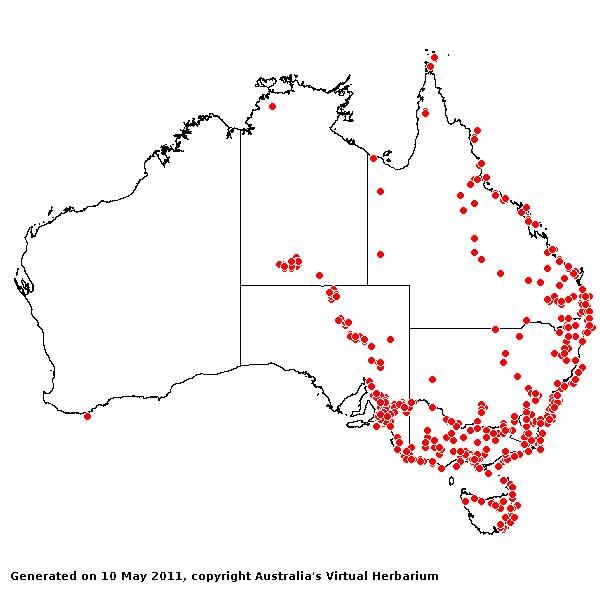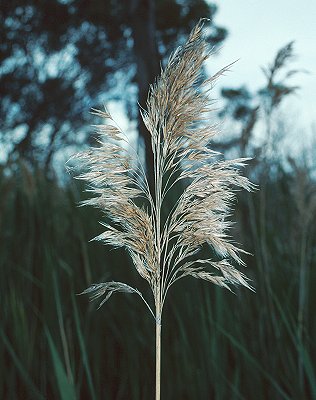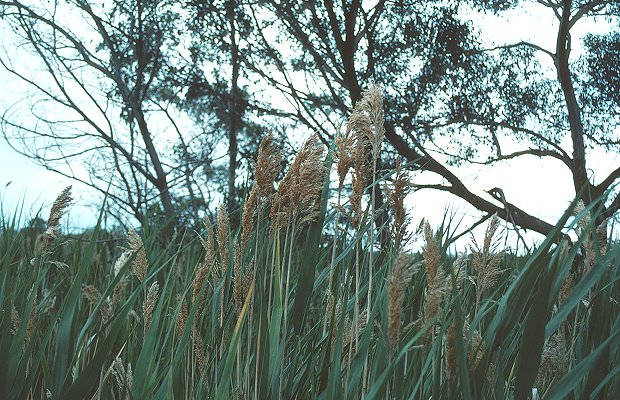Phragmites australis (Cav.) Trin. ex
Steud. Nom. Bot. ed. 2, 2: 324 (1841).
Classification.
(GPWG 2001) : Subfamily Arundinoideae. Tribe Arundineae.
Basionym and/or
Replacement Name: Arundo
australis Cav., Anales Hist. Nat. 1: 100 (1799).
Type of Basionym or
Protologue Information: HT: Anon., Australia (MA). HT discussed by
Clayton, Taxon 17: 168 (1968).
Recent synonyms:
P. communis.
Key references
(books and floras): [1810]. R.Brown, Prodromus (183 as Arundo
Phragmites), [1878] G.Bentham, Flora Australiensis 7 (636 as Phragmites
communis), [1980] M.Lazarides, Tropical Grasses S.E.Asia (438),
[2002] D.Sharp & B.K.Simon, AusGrass, Grasses of Australia, [2006]
J.Jessop, G.R.M.Dashorst, F.M.James, Grasses of South Australia (309),
[2008] S.W.L.Jacobs, R.D.B.Walley & D.J.B.Wheeler, Grasses of New South
Wales (340).
Illustrations:
[1984] N.T.Burbidge. rev. S.W.L.Jacobs, Australian Grasses (213), [2005] K.Mallet (ed.), Flora of
Australia 44B: Poaceae 3 (Fig.1,A-D), [2006] J.Jessop,
G.R.M.Dashorst, F.M.James, Grasses of South Australia (310, fig. 242), [2008] S.W.L.Jacobs,
R.D.B.Whalley & D.J.B.Wheeler, Grasses of New South Wales, 4th edn
(340).
Habit.
Perennial. Rhizomes present, elongated. Basal leaf sheaths absent. Culms erect,
stature reed-like, 100–600 cm tall. Leaves cauline. Ligule a fringed membrane,
a ciliate membrane. Leaf-blades 20–60 cm long, 8–32 mm wide. Leaf-blade surface
smooth.
Inflorescence.
Inflorescence compound, a panicle. Panicle oblong, dense, 20–50 cm long, 6–15
cm wide.
Spikelets.
Spikelets pedicelled. Fertile spikelets many flowered, with at least 2 fertile
florets (3–11), comprising 1 basal sterile florets, comprising 3–11 fertile
floret(s), with diminished florets at the apex, cuneate, laterally compressed,
10–18 mm long.
Glumes. Glumes
similar, similar to fertile lemma in texture. Lower glume lanceolate,
membranous, without keels, 3–5 -nerved. Upper glume lanceolate, 5–9 mm long,
membranous, without keels, 3–5 -nerved. Upper glume apex muticous or mucronate.
Florets. Basal sterile florets 1, male or barren, with palea. Lemma of
lower sterile floret 100 % of length of spikelet, membranous, 3–7 -nerved.
Fertile
lemma 9–13 mm long, without keel, 1–3 -nerved. Lemma surface glabrous. Lemma
apex muticous. Palea 2 -nerved. Lodicules present. Anthers 3 (2 in sterile
floret). Grain 1.4 mm long.
Continental
Distribution: Europe, Africa, Temperate Asia, Tropical Asia, Australasia,
Pacific, North America, and South America.
Australian
Distribution: Western Australia, Northern Territory, South Australia, Queensland,
New South Wales, Victoria, Tasmania, Lord Howe.
Western Australia:
Eyre. Northern Territory: Central Australia South. South Australia:
Lake Eyre, Flinders Ranges, Northern Lofty, Murray, Southern Lofty,
South-eastern. Queensland: Burnett, Cook, Darling Downs, Maranoa,
Moreton, Port Curtis, Wide Bay, Burke, North Kennedy, South Kennedy. New
South Wales: North Coast, Central Coast, South Coast, Central Tablelands,
Southern Tablelands, Central-Western Slopes, South-Western Slopes,
North-Western Plains, South-Western Plains. Victoria: East Gippsland,
Eastern Highlands, Gippsland Highlands, Gippsland Plain, Grampians, Lowan
Mallee, Midlands, Murray Mallee, Otway Plain, Otway Range, Wilsons Promontory,
Riverina, Volcanic Plain, Wannon, Wimmera. Tasmania: Furneaux Group,
North West, North East, Midlands, East Coast, South West.
Notes.
H.J.Conert (Die Systematik and Anatomie der Arundineae (1961) recognises
a complex infraspecific taxonomy, W.D.Clayton (Kew Bull. 21: 114 (1967)
upholds two subspecies. The variation patterns are exceedingly complex: here I
recognise no subspecies. Distinct from P. karka by the longer glumes and
longer rhachilla hairs. Various authors use various other characters. Many
collections from Northern Queensland are difficult to assign to either species.
Dominant
or common clonal plant along rivers and streams in temperate zones of the
planet; sometimes found in semi-salt water and tidal systems, and along saline
springs. Flowers April to June.




